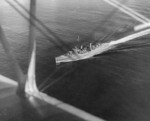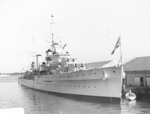Hobart
| Country | Australia |
| Ship Class | Leander-Class Light Cruiser |
| Builder | Royal Dockyard, Devonport, England, United Kingdom |
| Laid Down Date | 15 Aug 1933 |
| Commission Date | 13 Jan 1936 |
| Decommission Date | 20 Dec 1947 |
| Displacement | 7,105 tons standard |
| Bunkerage | 1,771.7 tons fuel oil |
Contributor: C. Peter Chen
ww2dbaseHMS Apollo, a 7,105-ton light cruiser, was built at Devonport, England, United Kingdom the first of a class of three, all of which ultimately served in the Royal Australian Navy. Completed in January 1936, she operated on the North America and West Indies Stations until mid-1938. Transferred to Australia in late September 1938, she was then renamed HMAS Hobart and served in Australian waters during the remaining peacetime months.
ww2dbaseFollowing the outbreak of war with Germany at the beginning of September 1939, Hobart cruised off Australia, in the East Indies and in the Indian Ocean to protect troop convoys en route to the war zone and to guard against the threat of enemy surface raiders. In April 1940 she went to the Red Sea, where she operated against Italian forces for several months. The cruiser served in the Mediterranean Sea during the last half of 1941, but was withdrawn when Japan began the Pacific War in December. She spent the rest of World War II in the Pacific. Her activities in 1942 included participation in the Battle of the Coral Sea in May and the invasion of Guadalcanal and Tulagi in August.
ww2dbaseHobart also operated extensively in the Coral Sea area, covering the Allies' vital south Pacific supply lines and protecting New Guinea from enemy surface threats. While steaming west of the New Hebrides on 20 July 1943, in company with the heavy cruiser Australia and three U.S. Navy destroyers, she was torpedoed by a Japanese submarine. Her after hull was seriously damaged, necessitating prolonged repairs at Sydney that kept her out of service until December 1944. During the rest of World War II, Hobart served in the Philippines and East Indies, taking part in amphibious landings at Cebu in March 1945 and Borneo in April-July. When Japan surrendered on 2 September 1945, she was part of the fleet anchored in Tokyo Bay to witness the event.
ww2dbaseFollowing the end of hostilities Hobart participated in the occupation of Japan, a duty that continued on and off for two years. She was decommissioned in December 1947 and placed in reserve. In 1953, she began conversion and modernization to prepare her for service as the Royal Australian Navy's training cruiser. However, this mission was cancelled in 1956, and she was returned to reserve. HMAS Hobart was sold for scrapping in February 1962 and was subsequently broken up in Japan.
ww2dbaseSource: Naval Historical Center
Last Major Revision: Jan 2005
Light Cruiser Hobart Interactive Map
Photographs
 |  |
Hobart Operational Timeline
| 1 Mar 1933 | The construction for HMS Apollo was ordered. |
| 15 Aug 1933 | The keel of HMS Apollo was laid down at the Royal Dockyard in Devonport, England, United Kingdom. |
| 13 Jan 1936 | HMS Apollo was commissioned into service. |
| 18 Mar 1938 | The British Chief of Naval Staff recommended the transfer of HMS Apollo to Australia. |
| 11 Jul 1938 | HMAS Albatross was recommissioned into service at Sydney, Australia to take a crew to the United Kingdom to man the cruiser soon-to-be transferred to Australia as HMAS Hobart. Albatross would departed Sydney later on the same day. |
| 6 Sep 1938 | HMAS Albatross arrived at Devonport, England, United Kingdom with a crew to man the cruiser soon-to-be transferred to Australia as HMAS Hobart. |
| 28 Sep 1938 | British cruiser HMS Apollo was recommissioned as Australian cruiser HMAS Hobart. |
| 19 Sep 1941 | Cruisers HMS Ajax, HMS Neptune, and HMAS Hobart arrived in Alexandria, Egypt after delivering supplies to Tobruk, Libya and began to embark troops of the UK 70th Infantry Division. |
| 28 Jul 1942 | US Navy and Marines began a four-day amphibious landing exercise at Fiji as rehearsals for the Guadalcanal landings set for two weeks later. |
| 17 Jul 1943 | Destroyers USS Nicholas, USS O’Bannon, USS Radford, and USS Jenkins departed Tulagi, Solomon Islands and joined cruisers HMAS Australia and HMAS Hobart with destroyers USS Lamson, HMAS Arunta, and HMAS Warramunga for two days of patrols in the shipping lanes between the Solomon Islands and Espiritu Santo, New Hebrides. |
| 20 Dec 1947 | HMAS Hobart was decommissioned from service. |
| 2 Apr 1967 | HMAS Hobart arrived at Osaka, Japan for scrapping. |
Please consider supporting us on Patreon. Even $1 per month will go a long way! Thank you. Please help us spread the word: Stay updated with WW2DB: |

» Dutch East Indies Campaign, Sumatra
» Battle of Coral Sea
» Guadalcanal Campaign
Related Books:
» Warship 2013
- » 1,182 biographies
- » 337 events
- » 45,119 timeline entries
- » 1,249 ships
- » 350 aircraft models
- » 207 vehicle models
- » 376 weapon models
- » 123 historical documents
- » 261 facilities
- » 470 book reviews
- » 28,412 photos
- » 365 maps
Winston Churchill